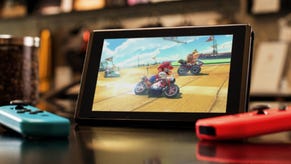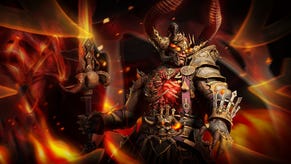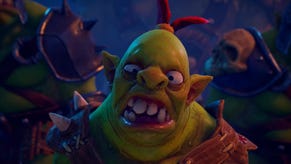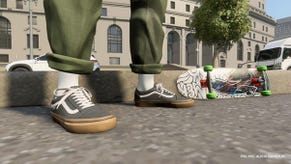Out of time: the Free Radical story – Part One
Born from GoldenEye 64 developer Rare, Free Radical Design's story is a long and complicated one. VG247's Dave Cook speaks with co-founder Steve Ellis to set records straight.
Somewhere within the English city of Nottingham, Free Radical co-founder Steve Ellis has corralled 143 employees into a bustling hotel conference room. This isn't a team-building exercise. Rather, he's brought them together to tell them that after months of missed deadlines, technical hiccups and frequent disagreements with publishers, they are all now unemployed. 39 lucky employees sat in the next room over, safe from the threat of unemployment. For now.
Recalled Ellis, “The administrators were concerned about doing it at the office because they didn't want an angry mob looting the place. To their credit though, people mostly weren't angry. They knew how we had got to where we were. They knew the efforts that everyone had made. They knew that every avenue had been explored.”
It's December 18th, 2008 and Christmas is just a week away.
Rare Talent
Ashby Computers & Graphics founders Tim and Chris Stamper were known among the gaming elite for their 8-bit label Ultimate Play the Game, and released a string of memorable 8-bit titles such as Jetpac and Sabre Wulf. In 1985 the brothers decided to spin out a new subdivision geared towards creating titles for Nintendo's NES home console. The studio was given the name Rare.
If you know your gaming history, you'll know that Rare quickly became a darling of the games industry, and produced a wide range of critically acclaimed and technically accomplished titles. From Donkey Kong Country and its sequels, to the brutal combat of Killer Instinct, Rare's star burned brightly from day one, but it shone even stronger with the herald of Nintendo 64.
Nintendo's then-powerhouse console saw Rare deliver what many perceive to be its watershed moments. Banjo-Kazooie, Perfect Dark and Jet Force Gemini may have cemented its place in the public subconscious, but arguably its crowning achievement was GoldenEye 64, a riotous multiplayer shooter that would both propel Rare to the height of gaming stardom and leave it a house divided. It was something of a bitter-sweet victory.
“The GoldenEye team was fairly unique within Rare at that time in that most of us had been to University,” Ellis explained. “We had ambition to do something more than working for a company - even a company like Rare. We wanted to be in control of our destinies and create a working environment that was like Rare but better.
“We also naively believed that we had done all of the work in bringing GoldenEye to market successfully, since we didn't see anyone else doing anything to help on a day-to-day basis. We later discovered the extent of the behind-the-scenes things that must have been going on to allow us to work in such a sheltered environment, shielded from deadlines, milestone approvals, and externally-enforced changes.
“As it became clear that GoldenEye was enjoying an extraordinary level of success, we realised that it might give us the opportunity that we needed to branch out and raise money to fund our own game. We discussed it through most of 1998, while saving some of our GoldenEye bonuses to help tide us over for a few months without an income, and in late 1998 Dave Doak and I left Rare.”
Although they had no debut project to their name, few publishers would deny Ellis, Doak and the rest of their team a meeting. After all, they were the guys who had achieved 8 million sales of GoldenEye in just over a year since launch. Eidos was the first publisher to offer this new renegade group – operating under the name Free Radical Design - a contract, and on April 1st 1999, Ellis and his team moved into their new office and began conceptualising the studio's first game Second Sight.
The dawn of time
Second Sight – codenamed internally as 'Redemption' - wasn't Free Radical's first release, but it was the game that secured the studio's pairing with Eidos. There was a loose premise in place that involved a game featuring psychic powers, but Ellis and his team decided to try their hand at a multiplayer shooter instead. They wanted a project that would set give them the tools and knowledge needed to get the best out of Sony's impending PlayStation 2 hardware.
Regarding Second Sight, Ellis explained, “It was ambitious and would take over two years to develop. However we also wanted to prove ourselves as soon as possible, to distance ourselves from the numerous other startups that were constantly starting up and subsequently failing. In summer 1999 we learned that the PS2 would launch in Europe and America at the end of 2000 rather than launching worldwide in March 1999 as had previously been intended.
“This delay was an opportunity. We had an engine running on the PS2, so if we could just change direction a little and make something without a complex narrative, we could conceivably have it ready for the PS2 launch. We had enjoyed multiplayer shooters and had had some success with GoldenEye, so it seemed like a good idea to try making a game that focused on that.
“We threw together a quick prototype and showed it to Eidos. Initially they declined it, preferring that we continued to work on 'Redemption', the game that we had signed with them. Undeterred by this, however, we continued to work on it on the side and showed it again to them in November 1999. This time they were convinced and we agreed to make TimeSplitters our first game, aiming for PS2 launch with 'Redemption' to follow in 2002.”
Although the PlayStation 2 hardware represented a significant leap over Sony's predecessor, Free Radical wasn't intimidated by the challenge of creating TimeSplitters in time for the console's European launch. Having been familiar with Unix and preferring Linux over Windows, the studio took to what Ellis described as “the Linux-based development environment” of Sony's rig with ease.
“The architecture was a good match for our abilities,” explained Ellis. “We wrote all of our code specifically for the PS2 and we made the decision to ignore the fact that we might later want it to run on other platforms. We could deal with that if and when the time came. The consequence: with a below-average team size, a below-average amount of time, and having to learn along the way how to build and run a company, we managed to hit PS2 launch with a game that wasn't embarrassingly bad.”
TimeSplitters launched in 2000 as promised, and Ellis was right: the game wasn't embarrassingly bad. In fact, it received a positive critical reaction and strong sales that would see it re-launch as a Platinum title in 2002. The game boasted a four-player, split-screen multiplayer mode that recalled the team's effort on GoldenEye 64, and showed – once again – that first-person shooters can happily exist in the analogue console world.
Looking at where the games industry is now, with its heavy focus on multiplayer games – shooters in particular – and it's clear that Free Radical retained Rare's eye for innovation and in second-guessing the market. That Timesplitters and GoldenEye 64 are still seen as two of the key precursors of modern shooters is testament to the studio's skill. But like Rare before it, Free Radical wasn't ready to take a break.
“TimeSplitters was an important milestone for us and we were incredibly proud of hitting it,” beamed Ellis. “It meant that we were a 'real' company that had actually released a game. We were no longer a startup. However we knew we could do better if we had more time. From the start the scope had been determined by the available time.
“We knew that it wouldn't be possible to have a complex narrative, so we didn't get distracted by trying to. We were aiming for a multiplayer sandbox where you had a huge amount of variety and freedom to play in different ways. I think we achieved that, but with a lot of clear areas to take forward in the sequel.”
Wasting no time
Although Free Radical was given life by Eidos on the basis of its Second Sight pitch, the studio still wasn't ready to shift focus back to its psychic action game. Instead, the team knew it had caught lightning in a bottle with TimeSplitters and it wasn't prepared to let the sparks fizzle out just yet. Talk of TimeSplitters 2 began shortly after the first game shipped, and it promised to raise the bar for console shooters everywhere.
“After TimeSplitters we were supposed to get back to working on 'Redemption'”, Ellis recalled. “However it was clear that TimeSplitters needed a sequel. Eidos weren't comfortable funding our growth to two teams at that time, so we agreed to make TimeSplitters 2 instead and take back 'Redemption'.
“TimeSplitters 2 had 23 months of development - still not a huge amount of time - but by that time we had a working engine from a released game, so it was enough time to upgrade the tech and add a decent single-player game.
“Again, preferring variety, we chose to go with a series of levels in distinct environments and time periods, with the dam as the first level as a nod to GoldenEye. We spent almost a full year working on that level to get all of the gameplay right and then spent the second year adding all of the rest of the levels.”
The Dam stage was indeed a phenomenal lesson in pacing, design and aesthetic prowess. It recalled the thrills of GoldenEye 64's opening stage, but arguably surpassed it, as if wrenching away Rare's torch and passing it to Free Radical by force. From a quiet and tense beginning to an explosive and deafening battle against a Russian gunship, TimeSplitters 2 opened with a warning shot to the world. Free Radical had truly arrived.
TimeSplitters 2's launch was met with critical acclaim among the gaming press, and runaway sales quickly followed. With a larger focus on campaign narrative, customisable multiplayer modes, riotous deathmatch play and an enhanced level builder, Free Radical had gone above and beyond the original game. It was a booming response to the 'tricky second album' problem that causes many entertainment creators to stumble.
On the press and public's positive reaction to TimeSplitters 2, Ellis explained, “I think that almost all games are influenced in some way by what has gone before, and it's hard to trace what has inspired what, so I wouldn't want to take undue credit for inspiring others. However, it's always nice to hear how much people enjoyed it.
“When you're making a game it can be hard to see past its flaws. Game development is all about making compromises and you know all of the things that you didn't get time to do, the things didn't manage to do as well as you had hoped and the bugs that you're not going to be able to fix.
“I've never reached the end of a project thinking 'this is amazing'. However I do recall one time towards the end, playing a 16-player game in the office against Eidos QA, thinking that we might have something special.”
With that 'something special' behind them, and the Free Radical name now a known force among the games industry, it was time to knuckle down and get Second Sight finished and out into the wild. However, the game had since changed publisher and was now tied to Codemasters, despite garnering the attention of industry juggernaut Activision at concept stage.
"From the start the intention was to have more than one team and preferably more than one publisher,” Ellis recalled. "Being a one-team company sounded incredibly risky, and even the idea of working on two games with one publisher made us nervous. If you only have one source of income, what happens if something goes wrong? We would later find out.”
20/20 Vision
The time had come for Free Radical to take a step back from TimeSplitters and return to its origins with Second Sight. The game starred John Vattic an amnesic who awakes with no memory of his past, but who now bears psychic and telekinetic powers. The game was received well among the gaming press, but didn't live up to the huge reaction surrounding TimeSplitters 2.
Regardless it shifted around one million copies in its life-span, which pleased publisher Codemasters and thrust the studio further into the publisher spotlight. The game may have fared better at retail under Activision, but we'll never know.
"Activision had wanted to work with us on 'Redemption' from the start," explained Ellis. "But we eventually signed with Eidos. However we still kept in touch with Activision, and when it looked like Eidos didn't want to sign the Gamecube version of TimeSplitters 2 - publishers didn't find it easy to work with Nintendo back then - we started exploring doing it with Activision.
"It almost happened too, but Eidos relented in the end. So instead we agreed to develop 'Redemption' for Activision. To distance it from TimeSplitters, and because we had been playing Metal Gear Solid, we decided to change it to third-person, but essentially it was the same game that we had signed to Eidos in 1999.
"Unfortunately, towards the end of 2003 Activision had a change of strategy, fired most of the people we had been working with and pulled out of UK development entirely. They cancelled something like ten games in one day. Since we owned the Second Sight IP we were able to take it to other publishers and eventually signed it - for a third time - with Codemasters.
"It was reasonably well-received, but I think the late change of publishers had resulted in there not being enough awareness of the game by the time it launched. These days we often see it featured in articles with titles like 'the best games you never played'".
With all eyes on Free Radical to see what it would do next, life was pretty comfortable at the Nottingham studio. Confidence was high, and while there was no 'master plan' set in stone, Ellis and the rest of the team didn't want to get carried away just yet. While the studio felt assured of TimeSplitter's quality, the franchise still wasn't getting the sales it deserved, so EA stepped in to make the the developer an offer for TimeSplitters: Future Perfect.
"TimeSplitters 2 had more critical success than commercial success," Ellis recalled, "particularly outside the UK. To put it bluntly, it didn't sell as well as we thought it should have, given its review scores. It sold about 2 million copies, where other lower-rated shooters were selling 3-5 million or more. EA noticed this, and came calling.
"They told us that if we let them publish TimeSplitters 3, they would be able to do better than Eidos had, and so the best way forward was to work with them. They were very convincing, and eventually we signed TimeSplitters 3 with them. It wasn't an easy relationship."
Indeed, EA wanted Free Radical to shift the focus of TimeSplitters 3 away from multiplayer and to create a deeper single-player experience. If you're a fan of the series you'll know that - while superb - TimeSplitter's heart beats strongest in multiplayer. To this day Ellis isn't sure if this shift, or some other force led the game to sell only 1 million units in its lifespan, but it was a dip neither party wanted.
Ellis explained that sales of TimeSplitters 3 wouldn't have been enough for EA, or any publisher at the time to justify a fourth game. Weak returns was one nail in the TimeSplitters coffin, but at this time - circa 2005 - production costs were spiralling to match Hollywood, and the answer became clear to Ellis and his group of renegades - it would have to raise the money by creating a new IP.
And its name would be Haze.
Stay tuned for part two of my Free Radical feature, in which Ellis and I discuss the untold story behind Haze, TimeSplitters 4, Star Wars: Battlefront III and more.













_XeCLKxB.png?width=291&height=164&fit=crop&quality=80&format=jpg&auto=webp)


